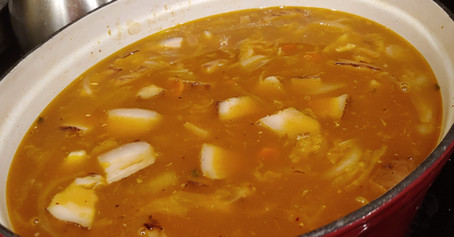Kimchi Jjigae
- Scott Johnson
- Apr 26, 2021
- 3 min read
Updated: Sep 4, 2022
During the pandemic I started making my own kimchi because I love the stuff, and I wanted to play around with how it's made. After a couple of batches I decided I was going to try my hand at this Korean kimchi, tofu, and pork belly stew. Since this soup uses two items that take over a week to make, this was both the longest cook time of any soup I've posted as well as close to the shortest, as the actual cooking process is fairly quick once all your ducks are in a row. To be fair, you can buy pork belly and kimchi already prepared and it would cut the preparation time down significantly, but there is something about having everything made from scratch that is rewarding when you finally take a spoon to your dish.
The flavor of this soup really pulls in all the components of the items while mellowing them down significantly. The sharp spicy fermented flavor of the cabbage is melted into the rich fat of the pork belly and broth just brightens everything up. With the underlying tones of fresh ginger, onions, and chili paste it has an amazing balance to it. As with most of my recipes, none of this is written in stone. If you want a spicier stew, bulk up the gochujang (fermented chili paste), gochugaru (Korean chili powder), ginger, or white pepper. For something that has more of a tart flavor try and include more of the kimchi broth to get that tang (if you don't have the liquid from the kimchi you can substitute lemon or lime juice, or even some rice wine vinegar).
An item to note is that older kimchi will have a more sour flavor. You actually want that profile being added to the soup so ideally you're using kimchi that's been around for a bit. Additionally you want the liquid that is in the kimchi, so much like when you squeezed out the cabbage and carrots when you made the dish in the first place, you will want to do the same with the kimchi, reserving the liquid that is removed for the soup. And lastly, when I made this dish, I made the kimchi early, then the pork belly. After the pork belly was finished I used the leftover braising liquid for part of the base of the soup (I bulked it out with chicken stock). This gave the soup a more intense flavor and used more of the product on hand that I had. If you don't have the braising liquid, no worries, just add more broth and season accordingly.
Ingredients
Onion, julienned 2 ea
Garlic, sliced 6 ea
Ginger, minced 3 oz
Chicken Stock 3 qt
Pork Belly 1-2 lb
Braising Liquid* 3 qt
Tofu, extra firm 1 block
Gochujang 1/4 cup
Gochugaru 3 T
Pineapple Juice 1 cup
Fish Sauce 3 T
Kimchi, with liquid reserved 4 cups
Scallions, thinly sliced, greens reserved 2 bunch
Sesame Oil 1 T
Coriander, ground 3 T
White Pepper, ground 3 T
Salt to taste
*This will be the leftover braising liquid, strained, from the pork belly if you are making your own. If you don't have this, you can bulk up the chicken stock, you will just need to adjust the flavors a little bit while making this soup.
Garnish
Scallions
Method of Procedure
Saute your onions, garlic, and ginger in sesame oil until softened.
Remove your tofu from the container and put on a plate. Add another plate on top and put some weight onto the top plate. Keep that on to remove the excess water for about 1 hour.
Slice your pork belly into bite size pieces and add to the pot (trying to get a little sear on them) and cook for another 10 minutes.
Squeeze out your kimchi, reserving the liquid, and add the cabbage to the pork and onions.
Combine your chicken stock and braising liquid, if you have any) and add it to the pot.
Slice your scallions reserving the green tops for the end and add the whites to the soup. Bring it to a simmer for 1 hour.
Dice your tofu into cubes.
Season the soup to taste and strain out about 2 quarts of the broth into a separate pot.
Bring the broth to a boil and put the diced tofu in for about 10 minutes*. Strain the tofu and chill, placing the broth back into the soup.
To serve, bring the soup to a boil and add scallion greens and your poached tofu cubes.
*By cooking the tofu off in this manner you impart some flavor as well as harden the skin on the outside.
























Comments